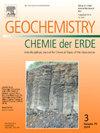印度东北西隆高原寒武系高钾成矿(i型)古瓦哈提花岗岩地球化学和年代学:包晶组合携带(PAE)模式的岩石成因
IF 2.9
3区 地球科学
Q2 GEOCHEMISTRY & GEOPHYSICS
引用次数: 0
摘要
包晶组合夹带(PAE)模型有效地解释了Fe、Mg、Ti和Ca的变化,以及Ti和Ca与基性i型花岗岩熔体中基性度[摩尔(Fe + Mg)]增加的正相关关系。对印度东北部西隆高原古瓦哈提地区新发现的奥陶系至寒武系富镁铁质i型花岗岩进行了全岩元素地球化学和锆石U-Pb-Hf同位素分析。主要地球化学特征为Ti与碱度、V、Ca、P呈正相关,而摩尔A/CNK与碱度呈负相关。这些模式表明,花岗岩形成于地壳中含水氧化铁矿物的不一致熔融,包括斜长石、铁钛氧化物和斜辉石的包晶组合。UPb锆石年龄(523±4.94 ~ 473±3.5 Ma)反映了古瓦哈蒂花岗岩的侵位年龄。锆石Hf同位素分析表明,锆石的两阶段模式年龄(TDM2)为2095 ~ 2036 Ma, εHf(t)值在- 10.66 ~ - 8.47之间。这表明古元古代大陆地壳对473±3.5 Ma奥陶系花岗质岩浆的形成有重要贡献。相比之下,寒武系花岗岩年龄在523 ~ 502 Ma,加权平均206Pb/238U年龄为513±36 Ma, TDM2略高,为2098 ~ 2092 Ma, εHf(t)为负,范围为- 9.95 ~ - 9.63。这些发现表明,在这两种花岗岩类型中,古代地壳源的参与是一致的。因此,奥陶系和寒武系古瓦哈蒂花岗岩的模式年龄和εHf(t)值具有显著的相似性,反映了它们形成的共同地质过程。总体而言,古瓦哈蒂花岗岩(523-473 Ma)与奥陶系-寒武系弧岩浆活动相关的泛非构造活动以及东冈瓦纳大陆板块组装期间印度、澳大利亚和南极洲碰撞后的构造-热事件有关。这一过程涉及古元古代基底地壳岩石的融化。本文章由计算机程序翻译,如有差异,请以英文原文为准。
Geochemistry and geochronology of high-K metaluminous (I-type) Cambrian Guwahati granites from Shillong Plateau, Northeast India: Insight into petrogenesis involving peritectic assemblage entrainment (PAE) model
The peritectic assemblage entrainment (PAE) model effectively explains variations in Fe, Mg, Ti, and Ca, as well as positive correlations of Ti and Ca with increased maficity [molar (Fe + Mg)] in mafic I-type granitic melts. This study analyzes the whole-rock elemental geochemistry and zircon U-Pb-Hf isotopes of newly identified Ordovician to Cambrian mafic-enriched I-type granites from the Guwahati region of the Shillong Plateau, northeastern India. The key geochemical features include positive correlations between Ti and maficity, along with V, Ca, and P, while molar A/CNK and maficity demonstrate a negative correlation. These patterns suggest the granites formed from the incongruent melting of hydrous ferromagnesian minerals in the crust, incorporating a peritectic assemblage of plagioclase, Fe![]() Ti oxides, and clinopyroxene. The U
Ti oxides, and clinopyroxene. The U![]() Pb zircon ages of 523 ± 4.94–473 ± 3.5 Ma demonstrate the emplacement age of the Guwahati granites. Zircon Hf isotopic analysis indicates a two-stage model age (TDM2) of 2095–2036 Ma with negative εHf(t) values between −10.66 and − 8.47. This suggests a significant contribution from Paleoproterozoic continental crust in the formation of the 473 ± 3.5 Ma Ordovician granitic magma. In comparison, the Cambrian granites, dated around 523 to 502 Ma with weighted mean 206Pb/238U age of 513 ± 36 Ma, exhibit a slightly higher TDM2 of 2098–2092 Ma and show exclusively negative εHf(t) values, ranging from −9.95 to −9.63. These findings indicate a consistent involvement of ancient crustal sources in both granite types. Consequently, it can be concluded that the Ordovician and Cambrian Guwahati granites share notable similarities in their model ages and εHf(t) values, reflecting common geological processes underlying their formation. Overall, the Guwahati granites (523–473 Ma) are linked to Pan-African tectonic activity associated with Ordovician-Cambrian arc magmatism and the tectono-thermal events following the collision of India, Australia, and Antarctica during the assembly of the Eastern Gondwana Landmasses. This process involved the melting of Paleoproterozoic basement crustal rocks.
Pb zircon ages of 523 ± 4.94–473 ± 3.5 Ma demonstrate the emplacement age of the Guwahati granites. Zircon Hf isotopic analysis indicates a two-stage model age (TDM2) of 2095–2036 Ma with negative εHf(t) values between −10.66 and − 8.47. This suggests a significant contribution from Paleoproterozoic continental crust in the formation of the 473 ± 3.5 Ma Ordovician granitic magma. In comparison, the Cambrian granites, dated around 523 to 502 Ma with weighted mean 206Pb/238U age of 513 ± 36 Ma, exhibit a slightly higher TDM2 of 2098–2092 Ma and show exclusively negative εHf(t) values, ranging from −9.95 to −9.63. These findings indicate a consistent involvement of ancient crustal sources in both granite types. Consequently, it can be concluded that the Ordovician and Cambrian Guwahati granites share notable similarities in their model ages and εHf(t) values, reflecting common geological processes underlying their formation. Overall, the Guwahati granites (523–473 Ma) are linked to Pan-African tectonic activity associated with Ordovician-Cambrian arc magmatism and the tectono-thermal events following the collision of India, Australia, and Antarctica during the assembly of the Eastern Gondwana Landmasses. This process involved the melting of Paleoproterozoic basement crustal rocks.
求助全文
通过发布文献求助,成功后即可免费获取论文全文。
去求助
来源期刊

Chemie Der Erde-Geochemistry
地学-地球化学与地球物理
CiteScore
7.10
自引率
0.00%
发文量
40
审稿时长
3.0 months
期刊介绍:
GEOCHEMISTRY was founded as Chemie der Erde 1914 in Jena, and, hence, is one of the oldest journals for geochemistry-related topics.
GEOCHEMISTRY (formerly Chemie der Erde / Geochemistry) publishes original research papers, short communications, reviews of selected topics, and high-class invited review articles addressed at broad geosciences audience. Publications dealing with interdisciplinary questions are particularly welcome. Young scientists are especially encouraged to submit their work. Contributions will be published exclusively in English. The journal, through very personalized consultation and its worldwide distribution, offers entry into the world of international scientific communication, and promotes interdisciplinary discussion on chemical problems in a broad spectrum of geosciences.
The following topics are covered by the expertise of the members of the editorial board (see below):
-cosmochemistry, meteoritics-
igneous, metamorphic, and sedimentary petrology-
volcanology-
low & high temperature geochemistry-
experimental - theoretical - field related studies-
mineralogy - crystallography-
environmental geosciences-
archaeometry
 求助内容:
求助内容: 应助结果提醒方式:
应助结果提醒方式:


